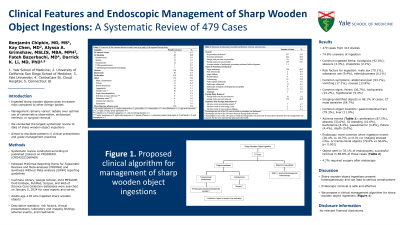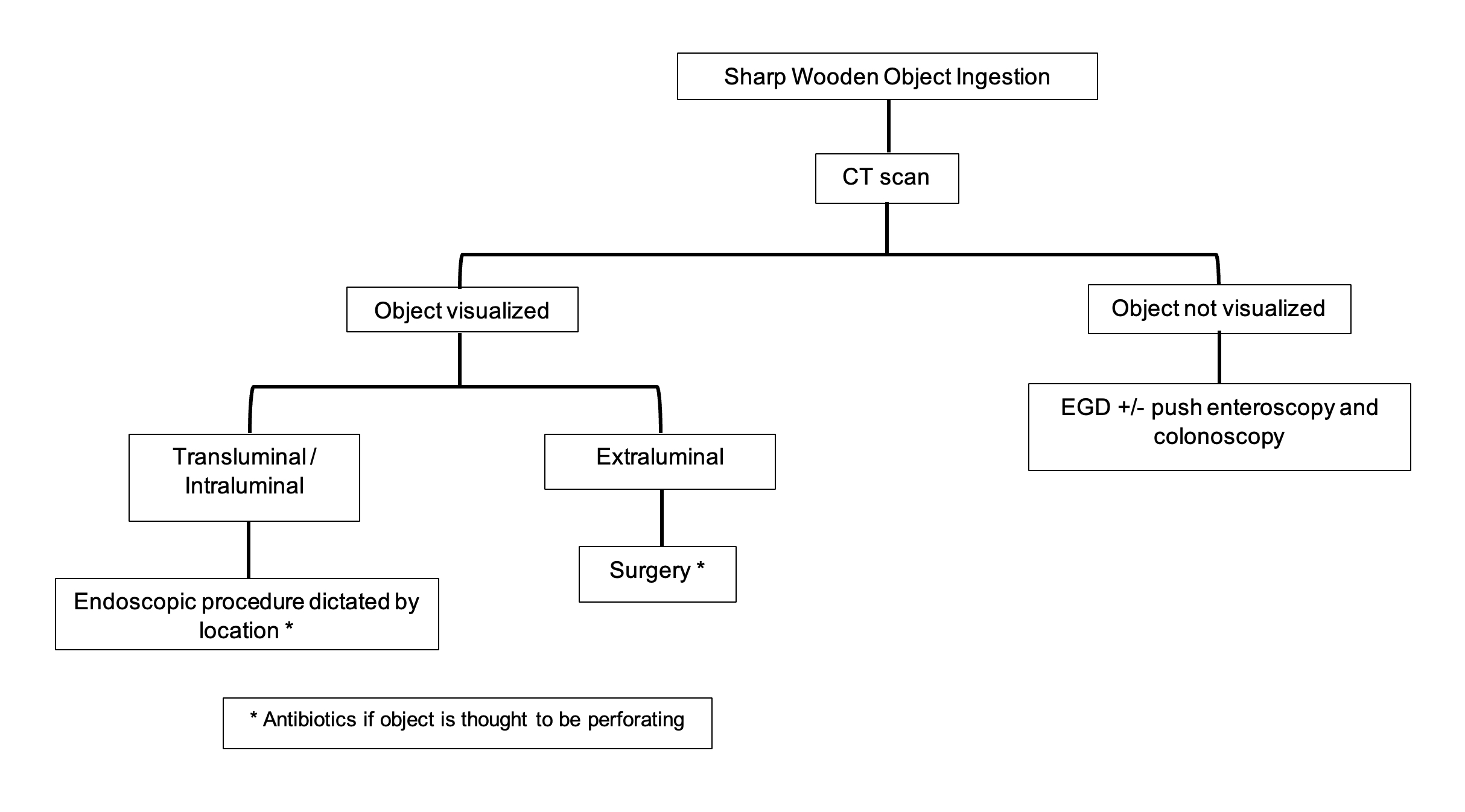Sunday Poster Session
Category: General Endoscopy
P0687 - Clinical Features and Endoscopic Management of Sharp Wooden Object Ingestions: A Systematic Review of 479 Cases
Sunday, October 27, 2024
3:30 PM - 7:00 PM ET
Location: Exhibit Hall E

Has Audio

Benjamin Chipkin, MD, MS
Yale School of Medicine
New Haven, CT
Presenting Author(s)
Benjamin Chipkin, MD, MS1, Kay Chen, MD2, Alyssa A. Grimshaw, MSLIS, MBA, MPH3, Fateh Bazerbachi, MD4, Darrick Li, MD, PhD5
1Yale School of Medicine, New Haven, CT; 2University of California San Diego School of Medicine, La Jolla, CA; 3Yale University, New Haven, CT; 4CentraCare St Cloud Hospital, St. Cloud, MN; 5Yale School of Medicine / Connecticut GI, New London, CT
Introduction: Ingested sharp wooden objects pose increased risks compared to other foreign bodies. Management remains varied, with debate surrounding optimal use of conservative observation, endoscopic retrieval, or surgical removal. We conducted the largest systematic review to date of sharp wooden object ingestions to elucidate patterns in clinical presentation and guide management practices.
Methods: The systematic review was conducted according to a published protocol on the PROSPERO and followed the Preferred Reporting Items for Systematic Reviews and Meta-Analyses (PRISMA) and Synthesis Without Meta-analysis (SWiM) reporting guidelines. Cochrane Library, Google Scholar, Ovid MEDLINE, Ovid Embase, PubMed, Scopus, and Web of Science Core Collection databases were searched for case reports and series of adults age ≥18 years who ingested sharp wooden objects. Descriptive statistics were reported for risk factors, clinical presentations, laboratory and imaging findings, adverse events, and treatments.
Results: Analysis of 479 cases from 413 studies showed that most were unaware of ingestion (74.8%) and toothpicks were the most commonly ingested item (92.5%), followed by skewers (2.3%) and chopsticks (2.1%). Risk factors included male sex (70.1%), substance use (9.4%), and edentulousness (6.1%) (Table 1). Common symptoms were abdominal pain (83.7%), vomiting (17.1%), and nausea (13.8%). Common signs were fevers (36.7%), tachycardia (14.2%), and hypotension (9.4%). Imaging identified objects in 48.1% of cases, with CT being most sensitive (54.7%). Objects were commonly found in the gastrointestinal tract (79.3%) and liver (11.9%). Endoscopy visualized objects 76.1% of the time, with successful removal in 88.8% of those cases. 4.7% of patients required surgery following endoscopic removal. Endoscopy was more common when ingestion was known (20.4% vs 10.7%, p=0.01) or imaging showed intra- or transluminal objects (79.6% vs 56.8%, p< 0.001). Antibiotic administration was reported in 45.9%. Adverse events included perforation (87.5%), abscess (33.0%), GI bleeding (10.0%), bacteremia (8.4%), pseudotumor (4.8%), and fistula (4.4%), with a mortality rate of 5.0%.
Discussion: Sharp wooden object ingestion presents heterogeneously and can lead to serious complications. Endoscopic removal is safe and effective. We propose a clinical management algorithm in Figure 1.

Note: The table for this abstract can be viewed in the ePoster Gallery section of the ACG 2024 ePoster Site or in The American Journal of Gastroenterology's abstract supplement issue, both of which will be available starting October 27, 2024.
Disclosures:
Benjamin Chipkin, MD, MS1, Kay Chen, MD2, Alyssa A. Grimshaw, MSLIS, MBA, MPH3, Fateh Bazerbachi, MD4, Darrick Li, MD, PhD5. P0687 - Clinical Features and Endoscopic Management of Sharp Wooden Object Ingestions: A Systematic Review of 479 Cases, ACG 2024 Annual Scientific Meeting Abstracts. Philadelphia, PA: American College of Gastroenterology.
1Yale School of Medicine, New Haven, CT; 2University of California San Diego School of Medicine, La Jolla, CA; 3Yale University, New Haven, CT; 4CentraCare St Cloud Hospital, St. Cloud, MN; 5Yale School of Medicine / Connecticut GI, New London, CT
Introduction: Ingested sharp wooden objects pose increased risks compared to other foreign bodies. Management remains varied, with debate surrounding optimal use of conservative observation, endoscopic retrieval, or surgical removal. We conducted the largest systematic review to date of sharp wooden object ingestions to elucidate patterns in clinical presentation and guide management practices.
Methods: The systematic review was conducted according to a published protocol on the PROSPERO and followed the Preferred Reporting Items for Systematic Reviews and Meta-Analyses (PRISMA) and Synthesis Without Meta-analysis (SWiM) reporting guidelines. Cochrane Library, Google Scholar, Ovid MEDLINE, Ovid Embase, PubMed, Scopus, and Web of Science Core Collection databases were searched for case reports and series of adults age ≥18 years who ingested sharp wooden objects. Descriptive statistics were reported for risk factors, clinical presentations, laboratory and imaging findings, adverse events, and treatments.
Results: Analysis of 479 cases from 413 studies showed that most were unaware of ingestion (74.8%) and toothpicks were the most commonly ingested item (92.5%), followed by skewers (2.3%) and chopsticks (2.1%). Risk factors included male sex (70.1%), substance use (9.4%), and edentulousness (6.1%) (Table 1). Common symptoms were abdominal pain (83.7%), vomiting (17.1%), and nausea (13.8%). Common signs were fevers (36.7%), tachycardia (14.2%), and hypotension (9.4%). Imaging identified objects in 48.1% of cases, with CT being most sensitive (54.7%). Objects were commonly found in the gastrointestinal tract (79.3%) and liver (11.9%). Endoscopy visualized objects 76.1% of the time, with successful removal in 88.8% of those cases. 4.7% of patients required surgery following endoscopic removal. Endoscopy was more common when ingestion was known (20.4% vs 10.7%, p=0.01) or imaging showed intra- or transluminal objects (79.6% vs 56.8%, p< 0.001). Antibiotic administration was reported in 45.9%. Adverse events included perforation (87.5%), abscess (33.0%), GI bleeding (10.0%), bacteremia (8.4%), pseudotumor (4.8%), and fistula (4.4%), with a mortality rate of 5.0%.
Discussion: Sharp wooden object ingestion presents heterogeneously and can lead to serious complications. Endoscopic removal is safe and effective. We propose a clinical management algorithm in Figure 1.

Figure: Figure 1. Proposed clinical algorithm for managing a confirmed case of sharp wooden object ingestion.
Note: The table for this abstract can be viewed in the ePoster Gallery section of the ACG 2024 ePoster Site or in The American Journal of Gastroenterology's abstract supplement issue, both of which will be available starting October 27, 2024.
Disclosures:
Benjamin Chipkin indicated no relevant financial relationships.
Kay Chen indicated no relevant financial relationships.
Alyssa Grimshaw indicated no relevant financial relationships.
Fateh Bazerbachi indicated no relevant financial relationships.
Darrick Li: Phathom Pharmaceuticals – Speakers Bureau.
Benjamin Chipkin, MD, MS1, Kay Chen, MD2, Alyssa A. Grimshaw, MSLIS, MBA, MPH3, Fateh Bazerbachi, MD4, Darrick Li, MD, PhD5. P0687 - Clinical Features and Endoscopic Management of Sharp Wooden Object Ingestions: A Systematic Review of 479 Cases, ACG 2024 Annual Scientific Meeting Abstracts. Philadelphia, PA: American College of Gastroenterology.
